Timothy Riesterer's Blog, page 14
September 22, 2017
Decisions or Deferrals?
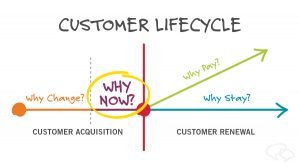
Or, why salespeople are struggling to create urgency with executive and financial buyers
The biggest threat to the health of your sales pipeline isn’t necessarily the competitors in your industry. In fact, there’s a good chance it’s stuck deals that fizzle out into “no decision.”
It’s one thing to get beat out by a competitor who out-marketed and out-sold you. But to lose to buyer inertia? Ouch. Unfortunately, “no decision” happens a lot in B2B sales. And it happens because many salespeople are not up to speed in the competencies they need to make a bigger impact with the decision-makers who matter most: That is, executive and financial buyers.
If it seems like executive buyers would rather defer decisions than make them, well…you can hardly blame them. There’s ample evidence suggesting that most of the salespeople they deal with lack the competence and confidence to engage them on their level, linking their executive-level business initiatives to the value of your solutions.
In fact, a recent Corporate Visions industry survey found the majority of companies aren’t satisfied with their ability to tell an executive-level story or craft a business case that creates urgency and helps justify a decision. More than two thirds of companies (67 percent) say they’re underperforming at getting executive-level prospects to buy now rather than later, while only 39 percent are confident in their ability to build a meaningful business and financial case to justify a decision.
So, if your deals are stalling out or you’re getting delegated down to decision-makers with less buying clout, it’s not because your most influential prospects don’t want to change—it’s because salespeople haven’t made a good enough business case for doing so.
“Why Now?”
The message that gets executive decision-makers to feel the urgency to buy now is what we’re calling the “why now” story. It’s a business-focused conversation salespeople need to master to secure buy-in from your most important prospects and customers.
Findings from a pair of analyst firms also reveal a major need for a tested and proven “why now” message framework. And, they shed some light on why so many proposals get stuck in the pipeline.
SiriusDecisions found that executives value business expertise four times more than conversations about products and services. On the other hand, Forrester Research found that executive buyers believe 88 percent of the sales professionals they encounter are knowledgeable about their own products and services, but only 24 percent are knowledgeable about the buyer’s business (think market trends, business issues, and the financial metrics that inform buying decisions).
Together, these data points tell you something pretty alarming about many sales conversations with executive buyers: today’s sellers are four times less likely to be good at the types of business conversations that executive buyers value four times more.
In other words, there’s a stark disconnect between what executive buyers are demanding from salespeople (i.e. business conversations) and what they’re actually getting from them (product presentations). This creates what I call a “business value gap” that undermines your credibility and threatens your ability to create a compelling and urgent business case.

The failure to address this gap should be a warning call for sales leaders that it’s time to up-skill salespeople on the competencies they need to be effective in their conversations with executives. Ultimately, executing against those competencies comes down to “three Cs”:
Salespeople must have the competence to understand the relevant external factors executives are dealing with, and how your prospects’ core business initiatives link to your business value, creating an executive buying vision.
They also need to have the confidence to engage executive decision-makers on their terms, in a business conversation—not a product presentation
Finally, salespeople must be able to make a compelling ROI justification that clearly illustrates business impact.
A tested and proven “why now” messaging framework will help salespeople (and marketers!) be more effective in these areas. In the second part of this blog, I’ll cover the brand new academic research we conducted with Dr. Nick Lee, a professor of marketing at Warwick Business School, that addresses the following question: What type of message creates the most urgency to get executive buyers to act now? The messaging approach, or “why now” framework, that stems from the study will help salespeople create more urgency with executives, so you can avoid the stalled proposals and “no decisions” that so often stand in the way of revenue success.
Stay tuned to see what the research says about how you should—or shouldn’t—approach this crucial “moment of truth” in the buying cycle.
The post Decisions or Deferrals? appeared first on Corporate Visions.
September 19, 2017
Enabling the Situational Salesperson

The technology to make just-in-time, situational learning a reality has been ready to deliver for a while. So, what’s been lagging? It’s the content. Without the right content, the best enablement technology in the world won’t be much good at giving your reps the messaging, content and skills coaching they need to master the moment. And situational sales enablement and execution will remain what it’s always been until now: a pipe dream.
But what if you could unite your marketing messaging and sales coaching and skills into a single, unified learning experience? And what if you could equip salespeople with stories that are tested and proven to help salespeople across the most pivotal moments they face, while giving them skills training competencies that are chunked, virtualized, and matched to the key messages in the customer lifecycle? What if salespeople had access to this kind of interactive experience anywhere, anytime, so they can actually operate as just-in-time situational learners?
That’s the kind of learning and execution experience covered in our latest eBook: Enabling the Just-in-Time, Situational Learner. In it, you’ll learn what it takes to eliminate the barriers to make situational, in-the-moment learning a powerful reality.
The post Enabling the Situational Salesperson appeared first on Corporate Visions.
September 12, 2017
How Do You Disrupt Your Buyer’s Status Quo Mindset?
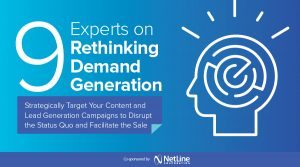
Status quo bias—or our natural preference for avoiding change—is the biggest threat to your success. After all, more than 60 percent of qualified pipeline deals fizzle out in “no decision,” according to Sales Benchmark Index.
This runs counter to the common idea that it’s the competitors in your industry you need to outperform and topple. In reality, when you’re trying to acquire a new customer, what you’re really battling against is your prospects’ preference for inaction. That’s your real enemy. The mindset that favors the supposed comfort of the status over a different and better alternative is what you need to disrupt.
Disrupting the status quo is such a daunting challenge for B2B marketers and salespeople because four main causes of status quo bias stand in your way. In this eBook, Tim Riesterer, co-author of The Three Value Conversations, is among nine featured industry experts who discuss how to disrupt the status quo bias and drive more revenue with your demand generation programs. In Tim’s section, you’ll get a crash course on the forces you need to overcome to defeat status quo bias and convince prospects to change to you.
Get the eBook: 9 Experts on Rethinking Demand Generation
The post How Do You Disrupt Your Buyer’s Status Quo Mindset? appeared first on Corporate Visions.
August 17, 2017
A Marketing and Sales Blind Spot?

Are companies so focused on early stage demand generation that they’re missing big opportunities to drive revenue in other key moments across the customer lifecycle?
Whenever marketers and salespeople are aligned on something—anything!—our natural tendency is to hail it as a victory—a rare moment of concord between two not-always-friendly factions.
Findings from a new Corporate Visions survey provide a snapshot of marketing and sales “alignment” that provides more questions than answers. Why? Because sometimes “consensus” actually has a downside. Sometimes the extreme alignment of priorities that marketers and salespeople appear to share could actually imply a missed opportunity.
We asked marketers and salespeople to rate a) which area of the customer lifecycle had the most impact on driving revenue; b) which area they dedicate the most resources to; and c) which area they need the most help with. The responses reveal that marketers and sales pros agree that early stage demand generation matters most across all these areas. Meanwhile, key post-purchase discussions, such as “ensuring ongoing renewals” and “expanding lifetime value,” finished near the bottom across all measures, often by significant margins.
The charts below shows just how closely the responses from marketers and salespeople track with each other in the questions we asked them. The trend lines were remarkably similar across all questions.
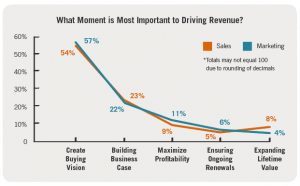
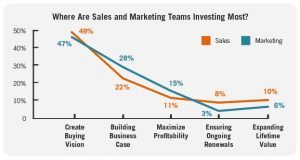
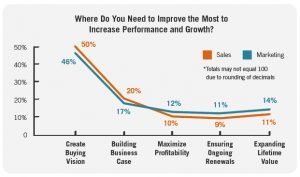
Seeing the Same Thing, Missing the Same Thing?
The overwhelming emphasis on early stage demand generation makes you wonder: Are marketers and salespeople so focused on the same thing that they’re also missing the same thing—in this case, the opportunity to ensure revenue growth by adding more messaging strategy to other key moments across the customer lifecycle, such as customer retention and expansion efforts?
Put another way: If everyone in the commercial operation is focused on the front-end of the business, who is making sure you’re driving profitable growth from existing customers and giving them a compelling reason not to leave.
Blind spots: Detected
The heavy emphasis on early-stage demand generation is clear. The question is, what blind spots is that creating around other major opportunities to maximize growth?
Blind spot #1: A one percent increase in price gains a 9 percent increase in operating margin. That finding, from McKinsey & Company, is especially relevant to two pricing-sensitive moments that are potentially being neglected: maximizing deal profitability and expanding lifetime value. As far as maximizing profitability during the deal, this stat underscores the importance of using specific messaging techniques that allow you to expand the scope and size of your discussions. For salespeople in deal-stage negotiations, that means introducing unconsidered needs to create pricing uncertainty, which expands the value of—and need for—your solutions. As it pertains to expanding lifetime value, this finding speaks to the importance of communicating price increases effectively—in a way that’s supported by research and that responds to how buyers actually behave in the moment when you’re trying to convince them to pay more.
Blind spot #2: A five percent increase in renewals increases profits by 25 percent. Bain & Company determined this impressive statistic, demonstrating that customer renewals are not an area you want to take lightly from a structure and strategy standpoint, particularly as many companies evolve to more of a products-as-a-service experience. This puts more pressure on securing the next agreement to drive growth and increase profitability. Unfortunately, skimping on the messaging rigor appears to be the norm when it comes to customer retention as four out of five companies say they want more strategy and structure around price increase messaging, according to a previous Corporate Visions industry survey.
Blind spot #3: Acquiring a new customer is anywhere between five to 25 times more expensive than keeping an existing one. Cited in a Harvard Business Review article, this stat isn’t so surprising when you consider that high startup and support costs can mean customers have to be an active account for months, even years, before they become fully profitable. Does this mean your budget needs to be allocated to better match the emphasis you want or need to place on the various moments in the customer lifecycle?
Marketers and salespeople may be in lockstep when it comes to perceiving the importance of early stage demand generation efforts. But don’t undermine those efforts by taking an ad hoc approach to some key growth-driving moments that occur later in the customer relationship, as that will only make it harder to retain customers and drive more value from your partnerships.
For more insights into what it takes to add more structure and strategy to the key moments highlighted above, check out our State of the Conversation Report.
The post A Marketing and Sales Blind Spot? appeared first on Corporate Visions.
What Banana Peppers Have To Do With Churn in Your Customer Success Program

My favorite salad and sandwich shop—where I’ve been eating lunch for many years—instituted mobile ordering last year. I used to go into the store and eat, or pick up a salad to go, but over the past few months, I’ve been pre-ordering on the mobile app so I can just fly in and out with my lunch order.
Last week I found myself in that shopping center at lunchtime, and decided I was hungry. So I did what I hadn’t done for months—I walked in and ordered a salad from the counter.
And it was depressing.
They used to know me! They knew I preferred half of their usual amount of banana peppers. They knew I liked the spicy chicken and not the breaded chicken. And they knew I liked wheat rolls instead of white.
But we lost that relationship when I switched to mobile ordering. I didn’t recognize their employees—and they sure didn’t recognize me!
Sure, they have lots of information about me from their app. They can monitor my order history. They can measure my purchases against trends in the market. And they can track my satisfaction through surveys.
But in moving our relationship from the store to my phone, they lost the opportunity to communicate with a salad-buying customer—all for the sake of better metrics.
Communication Starts With the Messages
I’m not simply bemoaning the death of customer service. That’s been argued enough.
But along with the improvements in service, profitability, and efficiency that came with their technology—they lost the art of communication with their customers. Once I became a profile in a computer, I stopped being a human that makes decisions based on actual conversations in the store.
The same challenge could be occurring in customer success organizations across all industries. Managing issue resolution and measuring customer satisfaction is critical to maintaining a healthy customer subscription base and reducing the barriers to renewal.
However, research conducted by my company shows that telling the wrong story at the wrong moment in the customer lifecycle could have tremendous negative impact on their intention to renew—and their likelihood to seek other solutions. And it could be causing the churn that they’re desperately trying to avoid.
To “Challenge” Or Not?
Many companies are training their sales teams in a provocative, challenging sales model that we’ve proven to be effective when you’re trying to convince a prospect to change from their status quo. We call that developing a “Why Change” message.
However, when customer success and account management teams are trying to retain customers, a provocative message can backfire. In fact, a recent survey showed 67 percent of companies are using the least effective message framework for renewal conversations.
Our research showed that using a provocative message in renewal situation makes customers 10 percent more likely to switch or shop around for other alternatives. In other words, using that disruptive message framework at renewal time makes your customer success team’s job 10 percent harder! On the other hand, giving them the right message framework for a renewal conversation would sure make that job easier. We call that framework the “Why Stay” story.
Cracking the Code for Communicating Price Increases
Your sales team strives to negotiate the best price they can when a new customer comes on board. But make no mistake: Those new customer acquisitions can eat into your profitability, particularly when you factor in the discounting that might’ve happened during the deal, not to mention the costs that often arise from over-servicing new accounts in the early days. As a result, many customer success and account teams need to make up some profit margin that may have leaked out during the sales process. One way to do that is by increasing the price at renewal time.
But how is your customer success team communicating a price increase? At what stage of the relationship are they bringing it up? And how confident do they feel in handling this notoriously delicate conversation?
Unfortunately, it’s a major exposure at many companies. Additional research indicates that using the wrong message framework and conversation strategy can cause attitudes to be nearly 20 percent less favorable about the message, while making customers 16 percent more likely to switch to another vendor.
It’s no wonder that another Corporate Visions survey showed that only eight percent of companies are “very confident” in their price increase requests, and that four out of five companies want more structure around price increase messaging. That structure should come from an effective message framework, with an anchoring strategy for price increase conversations that’s tested and proven to yield the most favorable results. That’s what we call the “Why Pay” message.
Modern customer success organizations have aligned people, processes, and technology in amazing ways to keep customers happy and maximize utilization of their services across the organization. But for all that investment, the research shows it could be the messages you’re using in your customer conversations that are working against you and potentially contributing to your customer churn.
The same is true in my relationship with my local salad restaurant. Darn banana peppers.
The post What Banana Peppers Have To Do With Churn in Your Customer Success Program appeared first on Corporate Visions.
August 15, 2017
When Marketing Stories and Sales Skills Converge
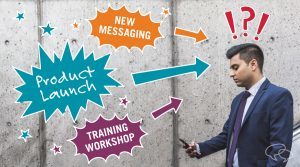
It’s Time for Just-in-Time, Situation-Specific Enablement
There’s all kinds of tools and apps promising to help your salespeople “in the moment”—across the different types of selling situations they face.
However, the marketing messaging, content assets and skills training needed to take advantage of these “situational sales enablement” technologies have not been ready, leading to many technology failures due to lack of adoption.
However, that is changing…and fast. Here’s a quick look at three trends happening right now that are making it possible to provide just-in-time, situational messaging, content assets and skills training to enable salespeople to have the right conversations at each stage of the customer lifecycle.
Situational Messaging Frameworks – one-size-fits-all messaging is being replaced with tested, proven frameworks for creating messages that work for different moments of truth in the customer lifecycle.
Situational Skills Training – stand-alone skills training over the course of days in classrooms is being replaced by short, compelling video-based skills coaching modules that are aligned to the various selling scenarios.
Integrated, Interactive Online Experiences – static playbooks are being replaced with interactive, mobile experiences that combine your stories and your skills in one situational messaging and coaching experience
It’s the convergence of stories (marketing messaging and content assets) with skills in a singular virtual experience for the salesperson. Imagine giving reps specific messaging and skills coaching for the exact selling situation they find themselves in — whenever and wherever they need it.
This changes the game significantly for product launches and training plans. You should no longer stand for stand-alone product messaging rollouts or isolated, skills-only training events.
That’s because your go-to-market strategies are not created equal, which means your messaging and skills need to be situational.
For example:
Some are for highly disruptive products or services that require you to challenge the status quo and create a need for change. This requires a messaging approach and distinct selling skills designed to defeat status quo bias and introduce the necessary urgency to change. For this scenario, you need to identify the unconsidered needs your prospects haven’t considered, and then map those needs to your unique capabilities, creating a buying a vision that gets prospects to see the value of doing something different than what they’re doing today.
Contrast this to a scenario where you are launching an upgrade to an existing product in a mature market where you are hoping to provide some differentiation that helps you take some share and protect your pricing premium. This requires a messaging approach and selling skills that de-commoditize the conversation and allow you to hold the line on discounts.
Or maybe, you are combining several products and services into a solution or key, topical initiative, hoping to elevate your sales conversations to more senior-level buyers? This requires yet another messaging model and a separate set of skills for salespeople to provide a business case that passes muster with executive and financial decision makers. Specifically, you’ll need to be effective at adopting an executive buyer’s perspective, conducting CXO-relevant industry or company research, showing the value of a business change scenario, and demonstrating your business impact.
In any of these cases, what good is it if you launch a bunch of messaging to the field and your salespeople don’t have the pre-requisite skills to execute the story — because your skills training program is on a completely separate track and timing?
Or the other way around…what good is it if your skills training courses teach your salespeople how to engage in each of these selling scenarios, but your messaging and content assets don’t align with or reinforce those skills?
The barriers to accomplishing this convergence of stories and skills have been eliminated, and the following factors are playing a major part in that:
Tested and proven messaging frameworks are now available for each key moment in the customer lifecycle – Why Change? Why You? Why Now? Why Pay? Why Stay? — ensuring your messaging is developed for maximum impact in each situation.
Skills training competencies are being chunked up and virtualized in short- and long-form eLearning content that matches each of those key moments in the customer lifecycle, and they can be attached to the messaging for situationally-relevant coaching on how to deliver the story as intended, using the same science to tell the story as you used to create the story.
All of this is being served up in an integrated, interactive format that can be accessed from anytime, anywhere by salespeople, including on their mobile devices without another piece of software or technology.
The days of stand-alone product launches, messaging rollouts or sales skills training are over, making way for just-in-time, situation-specific learning and execution.
This article originally published in CMO.com.
The post When Marketing Stories and Sales Skills Converge appeared first on Corporate Visions.
A Story of Renewal: Elements of a Great “Why Stay” Message
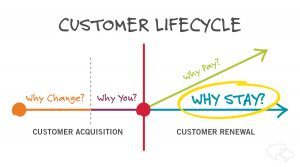
In a sales conversation, a great “Why Change” story is all about disruption. It sets the scene in your prospect’s world, then hammers away on the status quo, casting it as a dark and dangerous place where they can’t achieve their business goals. It’s like the ocean in Jaws. Things might be nice and refreshing at first, but disruption is circling around you, ready to bite at any moment. Then, at the precise right time, the story pivots to a better way, a provocative insight your prospect hasn’t even considered before. With your solution, your customer can be the heroic lifeguard that saves the day.
But in a Why Stay story, a renewal conversation where you’re looking to keep an existing customer, the story moves on a different arc. As it should. After all, the purpose of a Why Stay Story is fundamentally different than the Why Change story, as Corporate Visions research confirms.
The key finding from the research is that you need to do two things well to make the biggest impact with your renewal messaging:
You need to document the specific results of your partnership and share those first before trying to affirm why you were, and continue to be, the right choice for your customer.
You then need to provide more expanded detail about the recent advances in your solution that are helping your customers keep pace with the market and anything your competition is offering.
When it comes to what kind of message works best in a renewal scenario, the results speak for themselves.
Let’s go into a little more detail about the different elements of the best “Why Stay” story.
Act 1: Set the tone with recent successes.
A Why Change story sets the scene solidly in the world of a prospect’s goals and objectives. It presents what it is they want to achieve, both today and in the future. On the other hand, a powerful Why Stay story starts by showcasing the recent successes of working with your company. You might talk about how good things are going today, why they chose you in the first place, and how your relationship tracks well for the future. In other words, you want to validate their original decision to choose you, showing that you’ve helped shore up the key performance challenges you promised you’d improve at the outset.
Act 2: The status quo is your happy place.
Here you want to stabilize the reason why they chose you in the first place. And you do that by reminding them of the great decision they made years ago to go with your company, making you their new status quo. But as anyone knows, the best stories aren’t all about unicorns and rainbows. You need a dark storm brewing. You need conflict. In a story where you’re trying to lock up a renewal, that’s where the risk of change comes in. In this scenario, change is actually the villain. This is the opposite of the Why Change story, where change is the hero. But in a Why Stay story, part of the conflict comes from a competitor lurking around your customers, and from the idea that change is often costly and fraught with risk. Here, your job is to make the status quo the safest place imaginable. It’s your “happily ever after.” Of course, your customers are listening to the competition. A provocative outsider message can make change incredibly alluring. And make no mistake, your competitors are doing everything they can to make it as captivating as possible. But while change is exciting, it can be scary as well, and that’s exactly what you want to convey in your “Why Stay” story: Leave the status quo at your own peril!
Act 3: Mention the “cost of change” as a rising conflict.
At this point in the story, you’ve made your case that working with you has been great in the past, that the status quo (working with you) is a safe and lovely place, and that change can create instability and conflict. Now, you need to dig that conflict in a little further. In a “Why Stay” message, you need to explain how turning to a competitor could lead to a ton of turmoil. Here, you give them real world examples—the cost implications of changing vendors, the operating costs that have already been “sunk” to get your solution performing well, the new investments you’ve made in improving your solutions, the amount of time it takes to onboard all your people and get a new solution running optimally. It’s not just about the hassle of changing vendors, it’s the mountain of costs they’re underestimating or haven’t considered.
Resolution: Detail the competitive advantages of staying with you.
This is the part in the “Why Stay” story where the clouds clear, the sun pops out, uplifting music plays, and the best possible scenario is…to stay the course. At the end of the day, you need to convey that there’s no reason to take on all the unnecessary risks involved with change. You do this by reminding them that you’ve continued to update and tweak your program to keep pace with any other competitive offerings in the market, and that they’re getting the best available solution they can. In this way, you make the status quo as alluring as possible, one that feels valuable and right.
Here’s the great thing about telling a compelling Why Stay story: After renewing the relationship, you can build on your successes, adding chapter after chapter of your adventures together. So by the time the next renewal comes around, you have an epic saga to tell.
The post A Story of Renewal: Elements of a Great “Why Stay” Message appeared first on Corporate Visions.
A Story of Renewal: Elements of a Good “Why Stay” Message

In a sales conversation, a great “Why Change” story is all about disruption. It sets the scene in your prospect’s world, then hammers away on the status quo, casting it as a dark and dangerous place where they can’t achieve their business goals. It’s like the ocean in Jaws. Things might be nice and refreshing at first, but disruption is circling around you, ready to bite at any moment. Then, at the precise right time, the story pivots to a better way, a provocative insight your prospect hasn’t even considered before. With your solution, your customer can be the heroic lifeguard that saves the day.
But in a Why Stay story, a renewal conversation where you’re looking to keep an existing customer, the story moves on a different arc. As it should. After all, the purpose of a Why Stay Story is fundamentally different than the Why Change story, as Corporate Visions research confirms.
The key finding from the research is that you need to do two things well to make the biggest impact with your renewal messaging:
You need to document the specific results of your partnership and share those first before trying to affirm why you were, and continue to be, the right choice for your customer.
You then need to provide more expanded detail about the recent advances in your solution that are helping your customers keep pace with the market and anything your competition is offering.
When it comes to what kind of message works best in a renewal scenario, the results speak for themselves.
Let’s go into a little more detail about the different elements of the best “Why Stay” story.
Act 1: Set the tone with recent successes.
A Why Change story sets the scene solidly in the world of a prospect’s goals and objectives. It presents what it is they want to achieve, both today and in the future. On the other hand, a powerful Why Stay story starts by showcasing the recent successes of working with your company. You might talk about how good things are going today, why they chose you in the first place, and how your relationship tracks well for the future. In other words, you want to validate their original decision to choose you, showing that you’ve helped shore up the key performance challenges you promised you’d improve at the outset.
Act 2: The status quo is your happy place.
Here you want to stabilize the reason why they chose you in the first place. And you do that by reminding them of the great decision they made years ago to go with your company, making you their new status quo. But as anyone knows, the best stories aren’t all about unicorns and rainbows. You need a dark storm brewing. You need conflict. In a story where you’re trying to lock up a renewal, that’s where the risk of change comes in. In this scenario, change is actually the villain. This is the opposite of the Why Change story, where change is the hero. But in a Why Stay story, part of the conflict comes from a competitor lurking around your customers, and from the idea that change is often costly and fraught with risk. Here, your job is to make the status quo the safest place imaginable. It’s your “happily ever after.” Of course, your customers are listening to the competition. A provocative outsider message can make change incredibly alluring. And make no mistake, your competitors are doing everything they can to make it as captivating as possible. But while change is exciting, it can be scary as well, and that’s exactly what you want to convey in your “Why Stay” story: Leave the status quo at your own peril!
Act 3: Mention the “cost of change” as a rising conflict.
At this point in the story, you’ve made your case that working with you has been great in the past, that the status quo (working with you) is a safe and lovely place, and that change can create instability and conflict. Now, you need to dig that conflict in a little further. In a “Why Stay” message, you need to explain how turning to a competitor could lead to a ton of turmoil. Here, you give them real world examples—the cost implications of changing vendors, the operating costs that have already been “sunk” to get your solution performing well, the new investments you’ve made in improving your solutions, the amount of time it takes to onboard all your people and get a new solution running optimally. It’s not just about the hassle of changing vendors, it’s the mountain of costs they’re underestimating or haven’t considered.
Resolution: Detail the competitive advantages of staying with you.
This is the part in the “Why Stay” story where the clouds clear, the sun pops out, uplifting music plays, and the best possible scenario is…to stay the course. At the end of the day, you need to convey that there’s no reason to take on all the unnecessary risks involved with change. You do this by reminding them that you’ve continued to update and tweak your program to keep pace with any other competitive offerings in the market, and that they’re getting the best available solution they can. In this way, you make the status quo as alluring as possible, one that feels valuable and right.
Here’s the great thing about telling a compelling Why Stay story: After renewing the relationship, you can build on your successes, adding chapter after chapter of your adventures together. So by the time the next renewal comes around, you have an epic saga to tell.
The post A Story of Renewal: Elements of a Good “Why Stay” Message appeared first on Corporate Visions.
July 20, 2017
A Flat Tire, A Moment of Need, and a Skills Training Revolution

I had to change a flat tire on my daughter’s car the other day. This forced me to pop open the owner’s manual because I hadn’t changed a tire since…I can’t remember when.
Unsurprisingly, I didn’t memorize the owner’s manual when I bought the car. Nor was I paying much attention as the salesperson walked me around the car and showed me where the jack was.
What I was up against was something most of you have probably experienced at one time or another—a knowledge deficit. Thankfully, this is exactly the kind of situation where you and I learn best. It’s that tense, back-against-the wall moment where you have no alternative but to learn—where you need to know something, now!
Salespeople face this every day. They don’t remember your product launch or sales training event days too long after they happen, let alone months later. They are just-in-time, situational learners. My latest CMO.com column shows you the convergence of marketing messaging, content and skills training into a single, integrated learning experience—available in that moment of need! Specifically, I explore what it takes to make situational, in-the-moment learning possible—and effective—today.
The post A Flat Tire, A Moment of Need, and a Skills Training Revolution appeared first on Corporate Visions.
June 29, 2017
When Not To Challenge Your Customer

The call for B2B marketers and salespeople to always be challenging and disrupting the customer is a great piece of advice when you’re trying to acquire new business. But it’s actually very bad advice when you’re trying to keep your customers and convince them to pay more. In fact, disrupting your customer during a renewal or price increase discussion is exactly the wrong approach—one that could drive a great customer right into the arms of your competition.
Recently, my company conducted research exploring the pitfalls of applying a provocative message to renewal conversations, or the “why stay” discussion. Since then, we turned our attention to a related discussion that marketers, salespeople and account teams need to handle well: price increases.
Ongoing investments in servicing accounts and improving solutions all end up in the same spot: a post-purchase price increase conversation. The question is, how do you tell this story in a way that drives more revenue without jeopardizing existing customer relationships?
My company, Corporate Visions, collaborated with Dr. Nick Lee, a professor at the Warwick Business School in the U.K., on academic research to answer that very question—and determine the best messaging framework for what I call the “why pay” conversation.
The “Why Pay” Study
For the study, we recruited 503 participants to take part in an online experiment that simulated a renewal and price increase selling scenario. Participants were told they ran a small business and that a two-year contract with a vendor they’d hired to promote their health and wellness plan (and retain employees) was coming to an end, and it was now time to discuss a renewal and price increase.
We tested six different approaches. All the test conditions started by documenting business results to date and all requested the same 4% price increase for the next two-year agreement. Participants were divided into six different groups and placed into different experimental conditions. The range of conditions included a message that introduced a new insight designed to challenge a customer’s current perspective and situation. Other conditions offered certain types of price anchors and discounts (all landing at the same 4%). Another sought to reinforce the status quo bias—an approach our past research revealed to be effective in a renewal context.
The Results
The experiment revealed that the “challenging” provocation-based message that introduced an unconsidered need was the least effective in terms of framing a price increase—by a statistically significant margin.
Participants in the provocative condition were found to have:
18.8% less favorable attitudes toward the message.
In addition, participants in the provocation-based message were:
15.5% less likely to renew with their current vendor; and
16.3% more likely to switch to another vendor.
But the study didn’t just reveal what doesn’t work for the “why pay” story; it also shows what does. Specifically, the winning message, according to the study, is one that:
Reinforces the status quo bias while introducing key, new capabilities to solve existing needs—not introduce new needs, and;
Anchor high with the price increase request, before giving a loyalty discount if the buyer purchases within an advantageous timeframe.
The best performing messages in the study suggest that your message should open by documenting results to date before reinforcing status quo bias, introducing new capabilities and anchoring a high price increase before providing a loyalty discount.
You can view the full research in our new report on communicating price increases.
The big takeaway from this study? The disruptive message so popular today may work wonders when you’re trying to win net new customers. But beware: When you’re trying to convince customers to stay or pay more, that message will set you back in a big way—potentially making your customers susceptible to inroads from the competition.
Want to learn more about telling the right story for the key conversations outlined above? Check out our latest eBook, which covers the conversations above in-depth.
This article originally published in Demand Gen Report.
The post When Not To Challenge Your Customer appeared first on Corporate Visions.
Timothy Riesterer's Blog
- Timothy Riesterer's profile
- 3 followers



